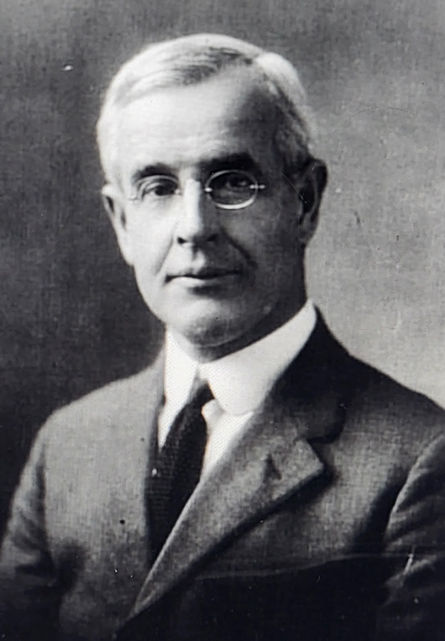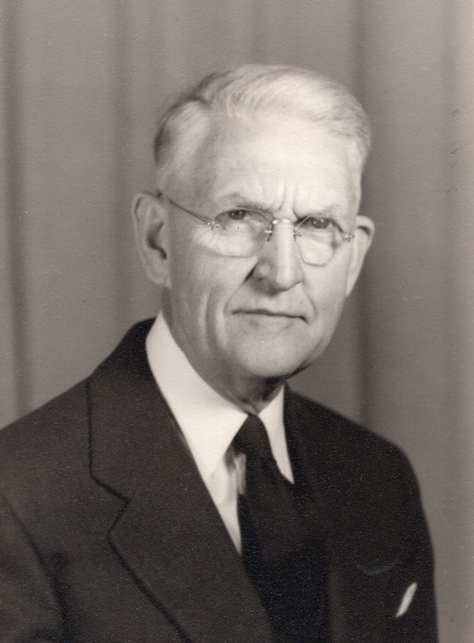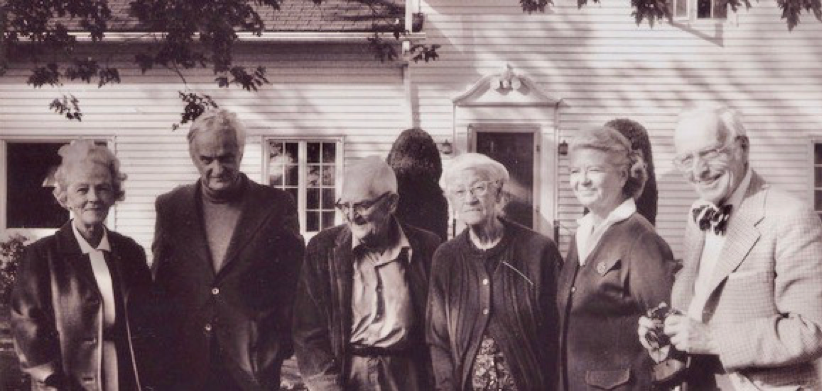The Story of Two Inspirational Ministers and Birders of Westport Point, Massachusetts by David Cole
Posted on March 12, 2024 by Jenny ONeill
Introduction
Scott Weidensaul, a well-known writer about birds and birding, published a book in 2007 entitled Of A Feather: A Brief History of American Birding. It covered famous authors and artists who had contributed to the literature on birds in North America from a first “bird book” produced by Mark Catesbury in 1726 to the famous recent author/artists such as David Sibley. Although he cites hundreds of birding authors, Weidensaul does not mention two Westport birders who made significant contributions to birding in the first half of the 20th Century – Smith Owen Dexter and Basil Douglas Hall. Both these men were Protestant Ministers, had residences within a mile of each other at Westport Point, were very close friends, collaborated on compiling records of local bird sightings, and had powerful influences on very disparate parts of the contemporary American birding community.
This document introduces them, describes their birding contributions, and provides evidence of their important activities in the appendices.
Download a PDF of the complete article:
Of a Feather: A Documentary Compiled by David C. Cole, April 2024
Smith Owen Dexter (1872-1936)

Smith Owen Dexter (1872-1936)
Smith Dexter was born in Barrington, RI, the son of a textile manufacturer. Although he was expected by his family to follow in his father’s footsteps, he was instead attracted to the ministry and pursued that career, being ordained in 1900, at the age of 28, and assigned to a church in New Bedford, MA. He remained at that church for four years, long enough to meet and marry a local woman, Helen Denison in 1902. After a posting as a missionary in Washington State he was assigned to the Episcopal Church in Concord, MA in 1907 where he remained for 25 years. Soon after moving to Concord, they purchased a house at Westport Point, an area that Helen had probably visited many times in her youth and to which he had become attracted while serving as a minister in New Bedford.
While he appears to have had an early interest in nature and birding, these were greatly stimulated by some of his parishioners in Concord and his neighbors and surroundings in Westport. His strongest connection in Concord was with neighbor William Brewster, the leading ornithologist of his time, who had co-founded the American Ornithologists Union, the Nuttall Ornithological Club, and was first president of the Massachusetts Audubon Society for 17 years. After Brewster died in 1919, Smith Owen Dexter edited two books of Brewster’s birding field notes entitled, Concord River and October Farm, published by Harvard University Press in 1936 and 1937 respectively.
In 1906, the year before Smith Owen Dexter arrived in Concord, William Brewster had published a major work entitled, The Birds of the Cambridge Region of Massachusetts, which provided detailed information collected by many members of the Nuttall Club on their bird sightings in a region comprising the towns of Cambridge, Watertown, Belmont, Lexington, Arlington and parts of Waltham, an area of about 50 square miles.[1]
One cannot help but wonder whether this widely heralded document might have inspired Smith Owen Dexter to undertake a similar compilation of The Birds of Westport, a somewhat similar area of 64 square miles, of which 50 were land and 14 were estuary. Whatever the inspiration, Dexter did set out to compile a record “of those birds seen within the limits of the Township or directly off our shores.” His explanation of the choice of this area was as follows:
“Few places in New England are more suited to the study of wild birds than the township of Westport. This is true for two reasons: first that the diversity of land and water attracts many kinds of birds; and then that the favorable climate holds them here at all seasons of the year. Nearly every condition of sea and land invites the birds. The birds, moreover, can be studied at every season of the year.”
In the introduction to The Birds of Westport, Dexter acknowledges his “debt to others for my material” as follows:
“The fishermen and gunners of the Village have greatly helped me, and especially William S. Head, who for many years has collected and observed the ocean birds. The accurate notes which Laurence Brooks of New Bedford and A. C. Bent of Taunton have kindly placed at my disposal have been of the utmost value. And the observations of Basil D. Hall have added many to the list of land birds.”
This is the only mention of Basil D. Hall in the notebooks, but it is recognition of a collaboration that had been evolving over several years. While all of the pages dealing with individual species in Book I have a small penciled “D” in the lower right hand corner, indicating they were entered by Smith Owen Dexter, in Book II covering Song Birds, 85 of the pages have a “D” and 33 have an “H” indicating that the entry was made by Basil D. Hall.
Also, the two notebooks were kept at the residence of Basil Hall at least for some of the years after Smith Dexter died. For some other years they may have been kept at the Westport Point Library on the property of Katherine Hall, Basil Hall’s sister. They were finally transferred to the Westport Free Public Library in 1967 by Basil Hall, as indicated in the Appendices, p. 18.
Basil Douglas Hall (1888-1979)

Basil Douglas Hall (1888-1979)
Basil Douglas Hall was born in New York City on January 1st, 1888, the son of Charles Cuthbert Hall (1852-1908) and Jeannie Stewart Boyd Hall (1857-1942). He was home schooled by a tutor and in 1902-03 he accompanied his parents, other family members and a tutor on a journey around the world during which his father delivered lectures on Christianity in India and East Asia.
In the summer of 1888, the year Basil was born, his parents, were invited by parishioners of his First Presbyterian Church in Brooklyn, NY, Lucius and Harriet Sheldon, to visit them at Westport Point, and fell in love with the area. The following year, they built Sinton, a splendid house on the crest of Eldridge Heights, with an unobstructed view out across open fields and the Westport River to the ocean. In 1890, the family began their annual pilgrimages, via the Fall River Line, from Manhattan to Fall River and on to Sinton, by one means or another, for the next century.
Not only was Basil Hall raised in an environment of natural and intellectual abundance, but his mother, captivated by her surroundings in Westport, became an ardent botanist who compiled two notebooks entitled “Partial List of the Flora of Westport for the Westport Point Memorial Library” and dated 1918. These notebooks are very similar to the two compiled by Smith Dexter (and her son Basil) on “The Birds of Westport” also dated 1918, except that her notebooks often displayed pressed plants rather than cutout images and descriptions of birds.
There is clear evidence that Basil had become very interested in birds well before Smith Dexter appeared in Westport. On April 28th, 1903, he began entering records of bird sightings and descriptions in a notebook entitled “BIRDS” belonging to Basil Douglas Hall, 46 East 70th Street, New York, N. Y. Some samples of these entries are found in Appendix 3. The entries demonstrate that, at the age of 15, he was already a skilled observer of both the songs, the physical features, and the habitat of the different species, perhaps influenced by the similar skills that his mother applied to flora. The entries also show the dates each year when the locus of observations shifted from New York City to Westport and back to New York.
Flocking Together
There are no entries in Basil’s “Birds” notebook for 1904-05. Then there are some entries in 1907 of birds seen on a trip to England, Scotland and Ireland, followed by another gap until 1912. During this latter gap, Basil attended Harvard, earning Bachelors and Masters Degree there in 1909 and then in 1912 theology degrees from Edinburgh and Union Theological Seminary in New York which his father had lead until his death in 1908.
One entry by Basil Hall in his “Birds” notebook on August 22, 1912, is of special interest because it describes a day of birding in Westport with Mr. Dexter, the first and only mention of him in this notebook:
- Joined Mr. Dexter just after breakfast. Took the automobile to the Let. There got on boat and cut across to Gooseberry Neck. A clear, warm day with light S.W. wind. On the upland first stirred a Meadowlark. Then a Savannah Sparrow. This bird is yellower than the Song Sparrow, especially around the head. Also has slower actions. Along the west shore saw several Ring Plovers, quantities of Spotted Sandpipers, a Herring Gull, a flock of Laughing Gulls, some Semipalmated Sandpipers.
- As we came back we raised a flock of five birds like large Sandpipers. At a distance of about a hundred feet we watched two of them resting on a rock. The black on the breast and throat was very marked. Also the reddish brown tone on the back. As we moved they flew up the coast and we stalked up through the grass. Had a fine view of them again close at hand. They were Turnstones in good plumage.
- As we came to our boat on the East shore two Red Breasted Mergansers (Sheldrakes) slunked down into the water and swam out into the bay. They are reddish brown on head and breast with white wing patches. More Laughing Gulls flew over. While waiting in a pine grove near the let saw and heard a Red-breasted Nuthatch. Later saw eleven Wild Ducks fly over the West River. (All these observations are on a one-day trip with Mr. Dexter, i.e. Smith Owen Dexter.)
As noted previously, Smith Dexter, who had purchased the house in Westport in 1910, was probably already engaged in compiling his record of The Birds of Westport, modeled on his neighbor – William Bradford’s Birds of the Cambridge Region. Basil Hall, who had continued to spend most of his summers in Westport when not traveling abroad, was, by 1912, going birding in Westport with Smith Dexter. Basil was a newly-minted Minister, who had spent most of his previous summers amongst the birds of Westport. Smith, who had recently begun spending his summers in Westport, was a more seasoned Minister who, in his Concord parish and academic and avian world of Cambridge was surrounded by the leading ornithologists of the day. In Westport, they forged a bond that lasted for nearly three decades until Smith Dexter died.
A third ministerial birder from this era was introduced to us in the enchanting book by Janet Wicks Gillespie – A Joyful Noise – relating the stories of her childhood growing up at Westport Point. Her father, Robert Russell Wicks, had married Basil Hall’s sister, Eleanor, and earned his spot on Eldridge Heights where they built a cottage called Snowden, on the western slope overlooking the West Branch of the Westport River.
Robert Wicks, referred to as “Pops” by daughter Janet, was a frequent birding companion of brother-in-law, Basil Hall, and neighbor, Smith Owen Dexter. Janet knew them as “Uncle Basil” – a real uncle, and “Uncle Smith” – an honorific uncle. Some of Janet’s stories about Uncle Smith, and particularly her recounting of how she made it into his notebooks, Birds of Westport, are recorded in Appendix 2.
Spreading the Birding Gospel
Following their collaboration on The Birds of Westport, Smith Dexter and Basil Hall reached out in very different directions to extend their linkages into the “Birding Community.” As mentioned previously, Smith Dexter devoted significant parts of his remaining years to editing and publishing the field notes of his close friend and neighbor, William Brewster, who had passed away in 1919. These efforts led to publication by the Harvard University Press of the two books, October Farm, in 1936 and Concord River, in 1937. A review in the journal, Auk, proclaimed that October Farm “should stand on one’s library shelf beside Thoreau’s ‘Journals” as another Concord classic.”
Basil Hall moved in a very different direction – motivating young men to take an interest in birding and devote their lives to “spreading the birding gospel.” Basil was appointed pastor of the Hunts Point Presbyterian Church in the Bronx from 1914 to 1921 and of the Lafayette Avenue Presbyterian Church in Brooklyn from 1921 to 1926. At both these churches he also served as Scoutmaster of the Boy Scout Troops that were connected to the churches. Obviously one of the key components of the programs that he promoted for those Scout Troops was appreciation and identification of birds.
This initiative paid off at the Bronx church in a big way. On November 29, 1924, a group of nine teenage boys from that Boy Scout Troop decided to form the Bronx County Bird Club.[2] The members of the Club committed to set up several bird-feeding stations in public parks in the Bronx and to report their bird-sightings to the club secretary, Joseph Hickey, who was to keep them as the official records of the Club.
Just over two years later, in January 1927, a tall, quiet 18-year-old arrived in New York City from the small town of Jamestown in western New York to study at the Art Students League. His name was Roger Tory Peterson. Although he was not living in the Bronx, he was admitted to the BCBC because he was such a “good” birder. Peterson, Hickey and a third member of the BCBC, Allan Cruickshank, went on to become leading birders and bird educators in the middle years of the 20th Century. Hickey was a Professor of Wildlife Management at the University of Wisconsin and succeeded Aldo Leopold as the head of that department.
Joe Hickey repeatedly acknowledged his debt to Basil Hall. In his book, A Guide to Bird Watching, published in 1943, he stated, p. 16, “Our beloved scoutmaster, the Reverend Basil Hall, had given us a helping hand,” and, when he gave a copy of the book Birds in Our Lives, published in 1970 by the US Fish and Wildlife Service, in which both Hickey and Roger Tory Peterson had chapters, Hickey wrote a note as follows: “For Basil D. Hall, Minister and Scoutmaster, with fond recollection of his encouragement back in 1919. Joseph J. Hickey, Christmas, 1970.”
Joe Hickey also arranged for a visit, together with Roger Tory Peterson and their wives, to the residence of Basil and Loraine Hall in Westerly, Rhode Island in 1978 when the following picture was taken.

Petersons on left, Hickeys on right
Smith Owen Dexter, building on the support and inspiration of his Concord parrishoners and friends as well as the favorable surroundings of Westport, added to the recording of bird observations as conveyed in the two notebooks he compiled with Basil Hall on Westport’s birds and also the two books of bird observations by his friend William Brewster that he brought to completion.
Basil Douglas Hall, building on the support and encouragement of his parents as well as his inherited and inherent skills as an observer and teacher, stimulated the already burgeoning talents of a group of exceptional young men to broaden public awareness and appreciation of the natural world around them.
The shared experiences of these two men, in the favorable physical and seasonal environment of Westport, reaped a bountiful harvest.
One further note: both these ministers, plus Basil’s father, Charles Cuthbert Hall, conducted services in the church at Westport Point. Basil Hall was the presiding pastor throughout 1959-1960. Charles Hall was an occasional guest minister who reportedly always attracted overflow worshipers. Smith Dexter, conducted a memorial service for President Warren G. Harding, who was assassinated in 1923.
[1] This publication represents an early example of what Joseph Hickey would later describe as “Regional Bird Studies.” See, Hickey, Joseph J. A Guide to Bird Watching, Oxford University Press, 1943, pp. 158 ff.
[2] Information about the Bronx County Bird Club and its founding members is in Appendix 4. It is also mentioned in Weidenthal, Of A Feather, pp. 185-6.
Download a PDF of the complete article:
Of a Feather: A Documentary Compiled by David C. Cole April 2024
